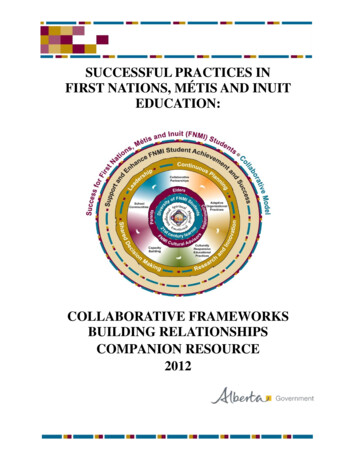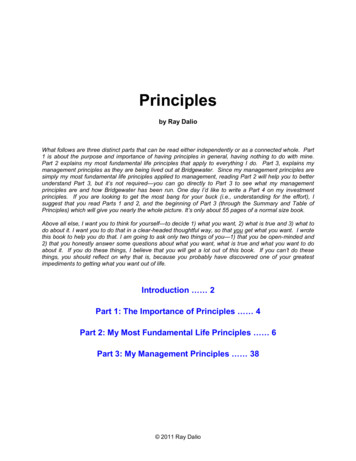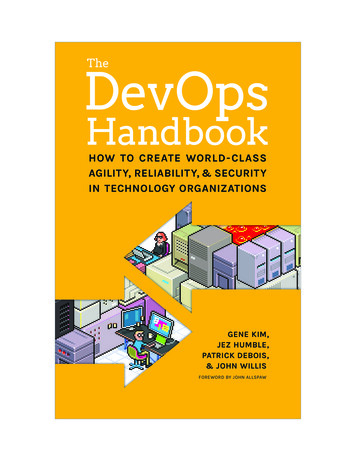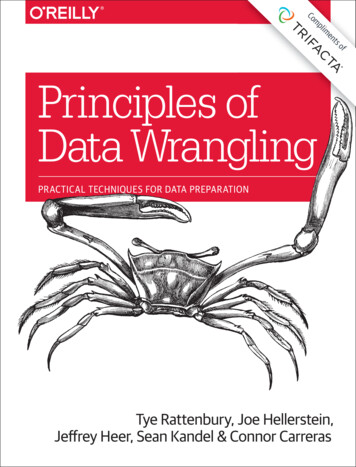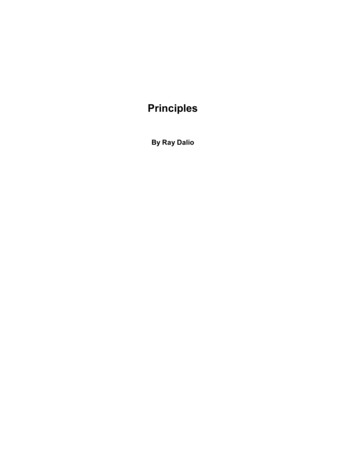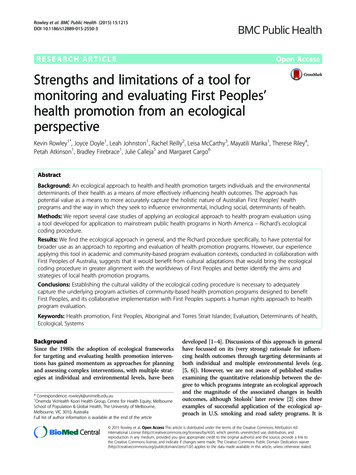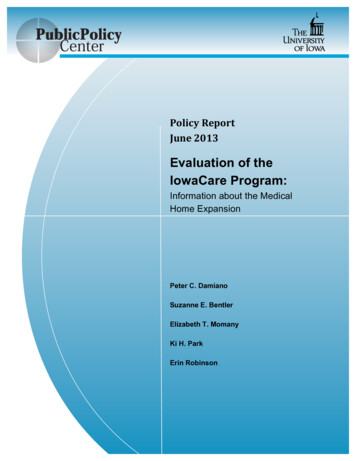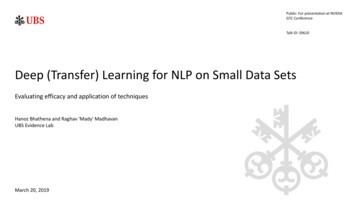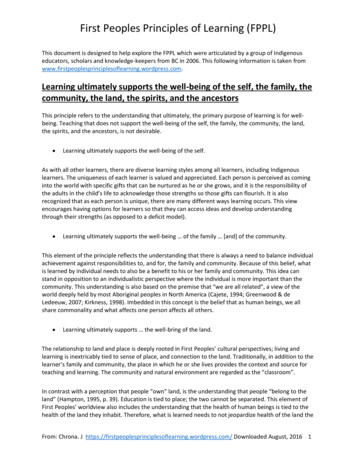
Transcription
First Peoples Principles of Learning (FPPL)This document is designed to help explore the FPPL which were articulated by a group of Indigenouseducators, scholars and knowledge-keepers from BC in 2006. This following information is taken .com.Learning ultimately supports the well-being of the self, the family, thecommunity, the land, the spirits, and the ancestorsThis principle refers to the understanding that ultimately, the primary purpose of learning is for wellbeing. Teaching that does not support the well-being of the self, the family, the community, the land,the spirits, and the ancestors, is not desirable. Learning ultimately supports the well-being of the self.As with all other learners, there are diverse learning styles among all learners, including Indigenouslearners. The uniqueness of each learner is valued and appreciated. Each person is perceived as cominginto the world with specific gifts that can be nurtured as he or she grows, and it is the responsibility ofthe adults in the child’s life to acknowledge those strengths so those gifts can flourish. It is alsorecognized that as each person is unique, there are many different ways learning occurs. This viewencourages having options for learners so that they can access ideas and develop understandingthrough their strengths (as opposed to a deficit model). Learning ultimately supports the well-being of the family [and] of the community.This element of the principle reflects the understanding that there is always a need to balance individualachievement against responsibilities to, and for, the family and community. Because of this belief, whatis learned by individual needs to also be a benefit to his or her family and community. This idea canstand in opposition to an individualistic perspective where the individual is more important than thecommunity. This understanding is also based on the premise that “we are all related”, a view of theworld deeply held by most Aboriginal peoples in North America (Cajete, 1994; Greenwood & deLedeeuw, 2007; Kirkness, 1998). Imbedded in this concept is the belief that as human beings, we allshare commonality and what affects one person affects all others. Learning ultimately supports the well-bring of the land.The relationship to land and place is deeply rooted in First Peoples’ cultural perspectives; living andlearning is inextricably tied to sense of place, and connection to the land. Traditionally, in addition to thelearner’s family and community, the place in which he or she lives provides the context and source forteaching and learning. The community and natural environment are regarded as the “classroom”.In contrast with a perception that people “own” land, is the understanding that people “belong to theland” (Hampton, 1995, p. 39). Education is tied to place; the two cannot be separated. This element ofFirst Peoples’ worldview also includes the understanding that the health of human beings is tied to thehealth of the land they inhabit. Therefore, what is learned needs to not jeopardize health of the land theFrom: Chrona. J .com/ Downloaded August, 2016 1
First Peoples Principles of Learning (FPPL)person lives on. Place is a way of knowing, experiencing, and relating with the world, and that theunderstanding of this anchors Indigenous peoples (Coulthard, 2010). Learning ultimately supports the well-being of the spirits, and the ancestors.That last section of this principle honours the understanding that people owe their lives to those whohave come before, and learning should respect what has been learned from those ancestors.Relation to Other Educational TheoryThe emphasis on relationship and connectedness in First Peoples’ world-views parallels the stress oncollaboration in constructivist learning. It supports the constructivist concept that learning is sociallyconstructed and the social constructivist theory learning occurs as a result of the individual’s interactionwithin a group or community (Vygotsky, 1978). The collaborative nature of group learning reflectsVygotsky’s understanding that social interaction is the necessary and primary cause of ontologicaldevelopment of knowledge in an individual (Glassman, 1994).Scardamalia and Bereiter (1994) also suggest that knowledge building is supported by intentional socialinteraction where participants provide constructive response to each other’s work, and the positiveeffect of collaborative learning is supported by Rogers and Ellis in their explanation of collaborationwithin the framework of distributed cognition (Rogers & Ellis, 1994) whereby knowledge is sharedthroughout networks of people.Implications for Classroom and School Include: Critically examining what is/has been considered important to teach and learn and why it is/hasbeen considered important (i.e. asking what agenda it serves).Critically examining what is being learned in terms of how it affects self, family, community andthe land.Connecting learning to the broader community. The classroom should extend beyond the walls ofthe classroom and school.Ensuring that there are multiple access points for students to learn.Ensuring that learners have various ways to represent what they learn.Making explicit connections to the social responsibility aspect of learning.Connect learning to broader community. Bringing in community members reinforces the linksbetween school and the rest of the learners’ lives.Beginning with looking at local contexts when examining topics or subject material, and thenmove outward.Engaging as much as possible with parents and extended family.From: Chrona. J .com/ Downloaded August, 2016 2
First Peoples Principles of Learning (FPPL)This document is designed to help explore the FPPL which were articulated by a group of Indigenouseducators, scholars and knowledge-keepers from BC in 2006. This following information is taken .com.Learning is holistic, reflexive, reflective, experiential, and relational (focused onconnectedness, on reciprocal relationships, and a sense of placeThis principle reflects the indigenous perspective that everything is interconnected and that education1) is not separate from the rest of life, and 2) relationships are vital. Learning is holistic Effective learning environments pay attention to the whole child, including the physical, mental,social/emotional, and spiritual aspects of the learner. The holistic nature of life and education arecentral and critical to the discussion about Indigenous views of education because they underpin firstPeoples’ understandings of human development and learning.The holistic nature of life and education reveals itself in multiple ways. The first of these is that there isnot a natural separation between the concept of education and the rest of a person’s experience.Learning is not viewed as an action separate from any other part of life. In a contemporary context, aperson’s experiences in school needs to be an authentic part of students’ life experiences rather than bedesigned or experienced as a preparation for a life to be lived later. This emphasizes an understanding ofeducation as contextual and integrated into all aspects of daily life. Where possible they should be a partof real-life situations, but where that is not possible, they should reflect real-life situations so that theknowledge learned is directly transferable to the learner’s life. In this way the learning also helps tocreate and support community.The holistic and integrative nature of life and education also manifests itself in the concept of the fouraspects of a whole and healthy being. Some Indigenous peoples use the concept of the Medicine Wheelto identify four aspects of being: mental, physical, spiritual, and emotional (Brown, 2004; Cajete, 1994;Calliou, 1995; Regnier, 1995; Weenie, 1998). It is important to note that these aspects do not exist inisolation from each other; they are viewed as equal and integrated parts of the whole, and each must beattended to simultaneously in the development of the whole person.Of particular relevance to a discussion of Indigenous worldviews with respect to education is theunderstanding that each of these four aspects carries equal value and weight. The development andattention to the spiritual and emotional domains of a person is as important as the consideration givento the mental and physical. A complete integration of the four aspects of the person can be seen asrunning contrary to a post-industrial Euro-centric worldview which some might argue,compartmentalizes these aspects of people’s existence, with only some being contained within thedomain of education or schooling. Ermine (1995) writes that “[w]estern science has habituallyfragmented and measured the external space in an attempt to understand it in all its complexity (p.103).He contends that this paradigm for understanding our existence hinders the ability to fully appreciatethe holistic nature of life.From: Chrona. J .com/ Downloaded August, 2016 3
First Peoples Principles of Learning (FPPL)It is important to understand that “spiritual” in First Peoples’ contexts does not equate with religiousbeliefs. It is not a discussion about worship. It is embedded in the understanding how the world works,and is core of First Nations cultures. Doige (2003) indicates that “[o]ne’s spirituality is the inner resourcethat facilitates knowing oneself, one’s surroundings, and finding meaning for one’s self in connectionand relation to those surroundings” (p. 146-7). Katz and St. Denise (1991) also indicate that in Aboriginalways of being in the world, both “the spirit and the heart are essential ways of knowing” (p. 31). Theimportance of nourishing the spirit is an integral part of learning.The other aspect of the person that cannot be separated from the mental and physical aspects of theperson is the emotional or “affective” capacity of a person. In fact, Brown (2004) posits that not only arethe heart and mind connected, but that the heart is the root of the mind. Thus the development of theaffective capacity is essential to the development of the cognitive capacity” (p.19). This attention to theemotional nature of life moves the concept of learning beyond mental capabilities and processes. Tofurther support this idea, Brown (2004) asserts that because the heart and mind are connected,“educating the mind alone is absurd” (p.10). Adding to this concept is the fact that in some first Nationslanguages, the word for mind and heart is the same word. Learning is reflexiveLearning is reflexive. It builds upon itself, exponentially increasing as learners develop new knowledgeand deeper understandings of how everything is ultimately connected. Learning is reflectiveLearning does not happen without reflection. Reflective thinking is a key process in coming tounderstand new concepts and determining the relevancy of information and ideas. It helps to makessense of new experiences and use them to learn by connecting them to what is already known.The emphasis on reflection is evident in a process of teaching and learning common to many FirstPeoples. In many of the stories shared by elders, there is an intention to help the listener learn what heor she needs to learn without explicitly saying what the lesson is. Often this story is repeated severaltimes in a life time and each time the listener is expected to decide for him or herself what needs to belearned from the story. Learning is experientialMeaning is made from direct experience. Learning is achieved by doing and thinking, through engagingin a hands (and minds on) approach. It “provides a tactile and tangible connection between knowledgeand life” (Battiste, 2002). The experiential aspect of making meaning from learning also reinforces theneed for meaningful reflection. Learning is relational (focused on connectedness, on reciprocal relationships, and a sense ofplace).From: Chrona. J .com/ Downloaded August, 2016 4
First Peoples Principles of Learning (FPPL)A recurring theme that surfaces in an examination of First Peoples' perspectives of education is theimportance of relationship. The concept of “we are all related” is understood by most First Peoples inBritish Columbia. It is a phrase echoed in many documents and uttered by many peoples. Imbedded inthis concept is the belief that as human beings, we all share commonality and what affects one personaffects others as well. Treating all people as related (or as kin) requires and reinforces a way of being inthe world that helps shape our actions. The concept of relationship also encompasses relationship toself, relationship to others (current and past) and relationship to place.The concept of relationship also encompasses “community”, and it is through the context of knowingone’s community that one can understand him or herself. It is also asserted that “ context is essentialin education and determines the meaning and application (added emphasis) of teaching and learning”(Cajete, 1994, p.165). Context can be understood to relate not only to the people, community, and placethat one is a part of, but also to the purpose of learning.In all discussions of relationship in indigenous contexts, there is both a sense of belonging to andrelating to others. This is tied to the idea of collective identity and responsibility (Cajete, 1994; DeneKede, 1993; Greenwood & de Ledeeuw, 2007; Kirkness, 1998). Learning is a highly social process thatnurtures relationships within the family and the community. In this context, the meaningfulincorporation of First Peoples’ world views, with their associated knowledge bases, values, beliefs andpreferred pedagogical practices, into the education system, would benefit both Indigenous and nonIndigenous learners.This principle also emphasizes the relationship to the land. In First Peoples’ cultural constructs, livingand learning is inextricably tied to sense of place and connection to the land. The community andnatural environment are regarded as the “classroom”, and “land was regarded as the mother of allpeople” (Kirkness, 1998, p. 10).Relation to Other Educational TheoryThe importance of reciprocal relationships in learning is also echoed by Scardamalia and Bereiter (1994),who also suggest that knowledge building is supported by intentional social interaction whereparticipants provide constructive response to each other’s work. In addition, the positive effect ofcollaborative learning is supported by Rogers and Ellis in their explanation of collaboration within theframework of distributed cognition (Rogers & Ellis, 1994) whereby knowledge is shared throughoutnetworks of people.The emphasis on the experiential nature of learning supports the constructivist approach to learningwhich emphasizes “knowledge and competence as products of the individual’s conceptual organizationof the individual’s experience” (von Glasersfeld, 2008, p. 48). Learners actively engage in experiencesthat allow them to develop new understandings based on the interaction of their prior experience andperceptions and the new experience. They construct knowledge through their learning experiences. Theemphasis on experiential learning is also supported by Brown, Collins and Duguid (1989) in theiremphasis on using authentic activity for learning.From: Chrona. J .com/ Downloaded August, 2016 5
First Peoples Principles of Learning (FPPL)Moon (2001) refers to the use of reflection as a significant learning tool in the processes of makingmeaning, working with meaning, and transformative learning - a continuum of "deep learning"processes where ideas are linked to each other, and integrated together before being restructured intonew understandings.A link to sense of place is also echoed in situated learning, another concept in constructivist pedagogy.Brown, Collins and Duguid (1989) emphasize that in order for learning to take place, activity andenculturation are paramount. They argue that knowledge is “situated, being in part product of activity,context and culture in which it is developed and used” (Brown, Collins & Duguid, 1989, p. 32).Knowledge is a tool to be developed and used in the appropriate, authentic context to becomemeaningful and learned effectively. While they emphasize the link between the learning and the activity,one can argue that the space or place of the learning also influences what is learned. In a similar vein,constructivist theorists view learning as highly contextualized; knowledge does not exist independent ofthe culture and history of people and place (John-Steiner & Mahn, 1996).Implications for Classroom and School Include: Developing a healthful relationship between teacher and learner. Relationship between teacherand learner is often considered one of the primary indicators of student success for manystudents.Integrating family (including extended family) and community members into the learningexperiences.Helping learners develop relationships with the surrounding community (both people and land).Developing cross-curricular learning experiences for learners.Including as much experiential learning as possible.Ensuring learners see relevancy in what they are learning.Providing choice and flexibility in activities so that different aspects of the whole self can beattended to.Using humour.Helping learners develop the skills they need for effective self-reflection.Respectfully incorporating the use of the circle for group discussion.Creating collaborative and cooperative learning opportunities.Providing apprenticeship options for learning.Providing opportunities for learners to mentor other students, or be mentored by others.Providing multiple access points for all learners in learning activities so that everyone can accessopportunities for learning.Providing multiple ways for learners to represent their learning.From: Chrona. J .com/ Downloaded August, 2016 6
First Peoples Principles of Learning (FPPL)This document is designed to help explore the FPPL which were articulated by a group of Indigenouseducators, scholars and knowledge-keepers from BC in 2006. This following information is taken .com. The website contains additional informationabout the history and current use of the FPPL in British Columbia.Learning recognizes the role of Indigenous knowledgeThis principle reflects the understanding that Indigenous peoples hold an extensive wealth ofknowledge, even if this knowledge has not always been recognized by post-industrial Euro-centriccultures (Battiste, 2005). It also recognizes that Indigenous knowledge contributes to the nonIndigenous understandings in the world. As one example, educators are now growing in theirunderstanding that the First Peoples Principles of Learning represent a highly effective approach toeducation that, among other things, supports deep learning, inclusivity, and responding to learners’needs.What is Indigenous Knowledge (IK)?IK can be broadly defined as the complex knowledge systems that have developed over time by aparticular people in a particular area and that have been transmitted from generation to generation. Itincludes ecological, scientific, and agricultural knowledge in addition to processes of teaching andlearning. It also encompasses both the traditional and the contemporary as Indigenous knowledgecontinues to expand and develop. Because Indigenous knowledge has often been referred to as“traditional knowledge,” some people view it as unchanging knowledge based only in the past. Instead itis “an adaptable, dynamic system based on skills, abilities, and problem-solving techniques that changeover time depending on environmental conditions” (Battiste, 2005). The body of IK can no more besummed up than the body of knowledge of any other society. It is vast, and based on context, oftenconnected to specific geographical areas.Inclusion of non-appropriated Indigenous knowledge (in the form of curriculum, resources, pedagogyetc.) in schools serves multiple purposes. It honours the fact that Indigenous peoples do have a robustand deep knowledge base that has been previously either ignored or denigrated (often as a part ofcolonial policies); it makes room in our schools for Aboriginal learners to see elements of who they arereflected around them (an often necessary condition for the success of almost all learners), and it helpsnon-Indigenous learner develop understandings to bridge some of the divide between Indigenous andnon-Indigenous peoples in Canada. Integrating the traditional Indigenous perspectives of teaching andlearning can also be immensely valuable in creating a more responsive education system for allstudents.Relation to Other Education TheoryConstructivism supports the belief that there is not one objective reality to which all learners aspire toknow and understand. Instead, the learner makes sense of the world based on his or her experiences init (von Glasersfeld, 2008). In this light, one can appreciate that there are different types of knowledge.While most societies tend to value some types of knowledge over others, one can also presume thatthere can be value found in knowledge systems of various cultures (Jegede, 1995).From: Chrona. J .com/ Downloaded August, 2016 7
First Peoples Principles of Learning (FPPL)Rather than criticize the learners’ perspectives if they seem to contradict the paradigms being promotedin the classroom environment, an effective educational experience helps articulate learners’ pre-existingconceptual understandings and uses these to help to create bridges to new understandings (Aikenhead& Jegede, n.d.). Jegede (1995) proposes that the cultural knowledge held by the learner, even when itmay seem to come into conflict with other concepts being taught, needs to be recognized, and can inmany cases be used to help learners understand concepts stemming from other cultural world-views.However, it is important to not view what has been traditionally taught in formal education as thepinnacle of learning. Providing opportunities for multiple ways of understanding the world can lead to adeeper understanding of the complexities of knowledge.Implications for Classroom and School Include: The willingness of educators to see themselves as learners, and seek to develop their ownunderstandings first.Understanding that education systems are not value neutral. Instead what is taught, and how it istaught reflects cultural values. Helping learners understand this may help them navigate throughdiffering cultural beliefs.Ensuring meaningful inclusion of Indigenous content and/or perspectives in all curricular areas(without appropriation).Recognizing that Indigenous knowledge is connected to specific contexts. There is a greatdiversity in First Peoples across not only Canada, but also within BC. Because of this, it isimportant to understand that teaching resources that might be appropriate and relevant in onecommunity might not be appropriate for another community or school district.Starting local. When deciding upon content that will be incorporated into the school orclassroom, begin by checking with any local First Nations communities or Aboriginalorganizations. Some may be able to help provide resources that are appropriate.Recognizing that local Aboriginal people can also be effective resources. This can be facilitated bydeveloping relationships with the local community or Aboriginal organization(s).Implications for Specific Curricular AreasWhile each of the following areas is described separately (and briefly), it is recognized that multidisciplinary educational experiences may better reflect the holistic emphasis of the FPPL. In general, theexplicit inclusion of Indigenous knowledge and perspective in the curriculum is based on theunderstanding that First Peoples perspectives and knowledge are a part of the historical andcontemporary foundation of BC and Canada. Practical applications of Indigenous knowledge arebalanced with deeply respectful spiritual practices leading to informed decision-making that is in thebest interest of self, others and the world around us“ (Michell et al, 2008).For Sciences - It is important to understand that there are additional perspectives of science that are notreflected in how science has been taught in schools (which is not always in accord with how science ispracticed outside of schools, what many refer to as contemporary science). Increasingly, both Canadianand international research has been “discovering” truths that have already long been known and sharedby First Peoples. Incorporating First Peoples’ perspectives and knowledge in school science can“broaden all people’s worldview and understanding of our interconnected relationship with the earthFrom: Chrona. J .com/ Downloaded August, 2016 8
First Peoples Principles of Learning (FPPL)and environment. Hence, incorporating First Peoples’ perspectives in school science has the potential toresolve social, cultural, and environmental crises that impact all humanity” (Michell et al. 2008).In "Education Indigenous to Place" (2007) Barnhardt and Kawagley share the richness of Indigenousknowledge in the context of Alaskan First Peoples. In BC, the First Nations Education SteeringCommittee (FNESC) and the First Nations Schools Association (FNSA) have developed a Science FirstPeoples 5-9 Teacher Resource Guide to help educators understand how to integrate local Indigenousknowledge into classrooms.For English Language Arts - It is important to understand that the word “story” in First Peoples’ contextshas a different meaning than it does in post-industrial Euro-centric contexts. Stories are narratives(traditionally oral, but now also written) that are used to teach skills, transmit cultural values and mores,convey news, record family and community histories, and explain our natural world. In First Peoplescontexts, stories do not equate with the construct of “short story” as is often taught in BC classrooms.They do not necessarily follow what is often taught as the conventional story structure (i.e. follow the“story arc”), and can often have complex circular or cyclical structures. The story is an evolving form inIndigenous cultures, as is evidenced by the powerful work of many contemporary story tellers whocreate story through spoken word, song, writing, and music. The explicit inclusion of Indigenousliterature (in its various forms) in BC schools and classrooms is based on the understanding that this isthe land from which that literature originates.In BC, provincial courses such as English First Peoples 10, 11, and 12 have rich teacher resource guidesthat can help educators navigate through potential resources to help teach these courses.For Social Studies - It is important to reframe some of the conversation around the history of Canada.There is increased awareness of the need to “teach social studies from the perspective of peoples whohave been traditionally marginalized in, or excluded from, national narratives told in schools. This shift inoutlook reflects a move away from engaging students with any singular conception of a national past,integrating multiple perspectives in the telling of Canada’s stories of origin, its histories, and themovements of its People” (Scott, 2013). This shift includes an age-appropriate examination of theeffects of colonization and the legacies of governmental policies over the history of Canada, includingResidential School policies, that have a significant effect on our society today. An inclusion of FirstPeoples perspectives in Social Studies classes requires a critical examination of what is consideredimportant to teach and learn.For Math - As with other curricular areas, there is growing recognition that education should beculturally responsive, and Math is no exception. Recent work on curricular resources in Math, such asThuuwaay, ‘Waadlu x an’: Mathematical Adventures (Nicola & Jovanovich, 2011) demonstrates that thelearning of Math can be approached through a culturally relevant lens. FNESC/FNSA have alsodeveloped a Math First Peoples Teacher Resource Guide for grades 8/9 to help educators integrate FirstPeoples knowledge into Math. In addition to these resources, exploring Math through an Indigenouslens is a part of the UBC Aboriginal Mathematics K-12 Network.From: Chrona. J .com/ Downloaded August, 2016 9
First Peoples Principles of Learning (FPPL)For Health and Physical Education - The emphasis on the need for balance integration of all aspects ofbeing, and the interconnectedness of a person’s physical, mental, spiritual and emotional aspects are ofparticular significance to the teaching and learning in Health curricula. In addition, as has been noted,the health of human being is linked to the health of the land and environment.Relation to Other Educational TheoryThe concepts of culturally relevant and culturally responsive curricula support the need to integrateindigenous knowledge in all curricular areas. This process has come to be termed by many researchersas “culturally relevant” or “culturally responsive” teaching, and it has been identified as a necessaryelement of student success (Allen&Labbo, 2001; Gay, 2002; Ladson-Billings, 1995; Young, 2010).However, the inclusion of First Peoples' knowledge and perspectives into classrooms for all students isnecessary for more than culturally relevant or responsive education. The knowledge and
Learning ultimately supports the well-bring of the land. The relationship to land and place is deeply rooted in First Peoples’ cultural perspectives; living and learning is inextricably tied to sense of place, and
